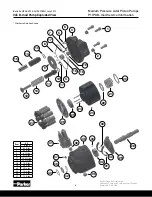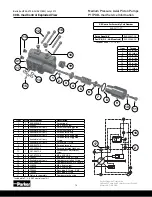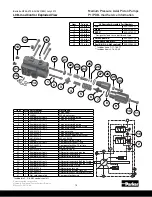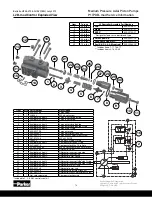
Parker Hannifin Corporation
Hydraulic Pump and Power Systems Division
Marysville, Ohio USA
Bulletin HY28-2708-02/SVC/EN | July 2019
Medium Pressure Axial Piston Pumps
P1/PD B-mod Service Information
5
General Information
Model Coding Information
For model code designation meaning and general model code information please see
P1/PD sales catalog HY28-2665-01/P1/EN.
Mounting
These pumps are designed to operate in any position. For shaft up, contact factory.
The pump shaft must be in alignment with the shaft of the source driver and should be
checked with a dial indicator. The mating pilot bore and coupling must be concentric.
This concentricity is particularly important if the shaft is rigidly connected to the driven
load without a flexible coupling.
Splined:
The shafts will accept a maximum misalignment of 0.005 in (0.15mm) total
indicator reading. Angular misalignment at the external and internal spline axis must be
less than ± 0,002 mm per mm of shaft radius, ± 0.002 inches per inch of shaft radius.
The coupling interface must be lubricated. PARKER recommends lithium molydisulfide
or similar grease. The internal coupling should be hardened to Rc 27-34 and must conform
to SAE-J498c, class 5 flat root side fit.
Keyed:
High strength heat treated keys must be used. Replacement keys must be hardened
to 27-34 Rc. The key corners must be chamfered 0.032-0.040 in (0.81-1.0 mm) at 45° to
clear radii that exist in the keyway.
Side Load Capability
The P1/PD series is designed for inline-drive. Side loading on the shaft is not recommended.
If this is unavoidable consult your nearest Parker representative.
Fluid Connections
Connect inlet and outlet lines to the port block of the pump. The maximum case pressure is
2 bar (30 psi) continuous, 4 bar (60 psi) intermittent. The case pressure must never exceed
inlet pressure by more than .5 bar (7 psi). When connecting case drain line make certain
that drain plumbing passes above highest point of the pump before passing to the reservoir.
The case leakage line must be of sufficient size to prevent back pressure in excess of 2 bar
(30 psi) and returned to the reservoir below the surface of the oil as far from the supply inlet
as possible. All fluid lines, whether pipe, tubing, or hose must be adequate size and strength
to assure free flow through the pump. An undersize inlet line will prevent the pump from
operating properly at full rated speed. An undersize outlet line will cause back pressure and
cause heat generation and increased noise. Flexible hose lines are recommended. If rigid
piping is used, the workmanship must be accurate to eliminate strain on the pump port block
or to the fluid connections. Sharp bends in the lines must be eliminated wherever possible.
All system piping must be cleaned and flushed before installing pump. Make sure the entire
hydraulic system is free of dirt, lint, scale, or other foreign material.
CAUTION:
Do not use galvanized pipe. Galvanized coating can flake off with continued use.
System Relief Valves
Although the P1/PD series pumps have very fast off-stroke compensator response, system
relief valves are recommended in all cases for safety considerations.
Recommended Fluids
The fluid recommended for use in these pumps has a petroleum base and contains agents
which provide oxidation inhibition and anti-rust, anti-foam and de-aerating properties as
described in Parker standard HF-1. Where anti-wear additive fluids are specified, see
Parker standard HF-0.
Viscosity Index
90 V. I. minimum. Higher values extend the range of operating temperature but may reduce
the service life of the fluid. Viscosity cannot be lower than 7 cSt.
Temperature
Determined by the viscosity characteristics of the fluid used. Because high temperatures
degrade seals, reduce the service life of the fluid and create hazards, fluid temperature
should not exceed 230°F (110°C) at the case drain.
Maintenance
The pump is self-lubricating and preventative maintenance is limited to keeping system
fluid clean by changing filters frequently. Keep all fittings and screws tight. Do not operate
at pressures and speeds in excess of the recommended limit. If the pump does not
operate properly, check the troubleshooting chart before attempting to overhaul the unit.
Overhauling may be accomplished by referring to the disassembly, rework limits of wear
parts, and assembly procedures as provided in this service manual.
Fluid Cleanliness
Fluid must be cleaned before and continuously during operation, by filters that maintain a
cleanliness level of ISO 20/18/14. Better cleanliness levels will significantly extend the life
of the components. As contaminant generation may vary with each application, each must
be analyzed to determine proper filtration to maintain the required cleanliness level.






































